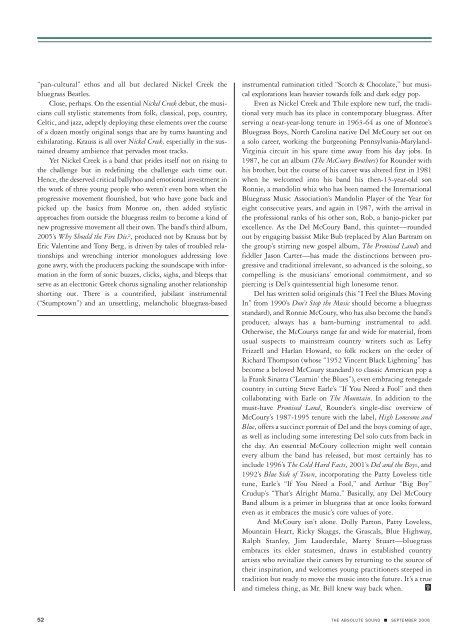The Cutting Edge
The Cutting Edge
The Cutting Edge
Create successful ePaper yourself
Turn your PDF publications into a flip-book with our unique Google optimized e-Paper software.
“pan-cultural” ethos and all but declared Nickel Creek the<br />
bluegrass Beatles.<br />
Close, perhaps. On the essential Nickel Creek debut, the musicians<br />
cull stylistic statements from folk, classical, pop, country,<br />
Celtic, and jazz, adeptly deploying these elements over the course<br />
of a dozen mostly original songs that are by turns haunting and<br />
exhilarating. Krauss is all over Nickel Creek, especially in the sustained<br />
dreamy ambience that pervades most tracks.<br />
Yet Nickel Creek is a band that prides itself not on rising to<br />
the challenge but in redefining the challenge each time out.<br />
Hence, the deserved critical ballyhoo and emotional investment in<br />
the work of three young people who weren’t even born when the<br />
progressive movement flourished, but who have gone back and<br />
picked up the basics from Monroe on, then added stylistic<br />
approaches from outside the bluegrass realm to become a kind of<br />
new progressive movement all their own. <strong>The</strong> band’s third album,<br />
2005’s Why Should the Fire Die, produced not by Krauss but by<br />
Eric Valentine and Tony Berg, is driven by tales of troubled relationships<br />
and wrenching interior monologues addressing love<br />
gone awry, with the producers packing the soundscape with information<br />
in the form of sonic buzzes, clicks, sighs, and bleeps that<br />
serve as an electronic Greek chorus signaling another relationship<br />
shorting out. <strong>The</strong>re is a countrified, jubilant instrumental<br />
(“Stumptown”) and an unsettling, melancholic bluegrass-based<br />
instrumental rumination titled “Scotch & Chocolate,” but musical<br />
explorations lean heavier towards folk and dark edgy pop.<br />
Even as Nickel Creek and Thile explore new turf, the traditional<br />
very much has its place in contemporary bluegrass. After<br />
serving a near-year-long tenure in 1963-64 as one of Monroe’s<br />
Bluegrass Boys, North Carolina native Del McCoury set out on<br />
a solo career, working the burgeoning Pennsylvania-Maryland-<br />
Virginia circuit in his spare time away from his day jobs. In<br />
1987, he cut an album (<strong>The</strong> McCoury Brothers) for Rounder with<br />
his brother, but the course of his career was altered first in 1981<br />
when he welcomed into his band his then-13-year-old son<br />
Ronnie, a mandolin whiz who has been named the International<br />
Bluegrass Music Association’s Mandolin Player of the Year for<br />
eight consecutive years, and again in 1987, with the arrival in<br />
the professional ranks of his other son, Rob, a banjo-picker par<br />
excellence. As the Del McCoury Band, this quintet—rounded<br />
out by engaging bassist Mike Bub (replaced by Alan Bartram on<br />
the group’s stirring new gospel album, <strong>The</strong> Promised Land) and<br />
fiddler Jason Carter—has made the distinctions between progressive<br />
and traditional irrelevant, so advanced is the soloing, so<br />
compelling is the musicians’ emotional commitment, and so<br />
piercing is Del’s quintessential high lonesome tenor.<br />
Del has written solid originals (his “I Feel the Blues Moving<br />
In” from 1990’s Don’t Stop the Music should become a bluegrass<br />
standard), and Ronnie McCoury, who has also become the band’s<br />
producer, always has a barn-burning instrumental to add.<br />
Otherwise, the McCourys range far and wide for material, from<br />
usual suspects to mainstream country writers such as Lefty<br />
Frizzell and Harlan Howard, to folk rockers on the order of<br />
Richard Thompson (whose “1952 Vincent Black Lightning” has<br />
become a beloved McCoury standard) to classic American pop a<br />
la Frank Sinatra (“Learnin’ the Blues”), even embracing renegade<br />
country in cutting Steve Earle’s “If You Need a Fool” and then<br />
collaborating with Earle on <strong>The</strong> Mountain. In addition to the<br />
must-have Promised Land, Rounder’s single-disc overview of<br />
McCoury’s 1987-1995 tenure with the label, High Lonesome and<br />
Blue, offers a succinct portrait of Del and the boys coming of age,<br />
as well as including some interesting Del solo cuts from back in<br />
the day. An essential McCoury collection might well contain<br />
every album the band has released, but most certainly has to<br />
include 1996’s <strong>The</strong> Cold Hard Facts, 2001’s Del and the Boys, and<br />
1992’s Blue Side of Town, incorporating the Patty Loveless title<br />
tune, Earle’s “If You Need a Fool,” and Arthur “Big Boy”<br />
Crudup’s “That’s Alright Mama.” Basically, any Del McCoury<br />
Band album is a primer in bluegrass that at once looks forward<br />
even as it embraces the music’s core values of yore.<br />
And McCoury isn’t alone. Dolly Parton, Patty Loveless,<br />
Mountain Heart, Ricky Skaggs, the Grascals, Blue Highway,<br />
Ralph Stanley, Jim Lauderdale, Marty Stuart—bluegrass<br />
embraces its elder statesmen, draws in established country<br />
artists who revitalize their careers by returning to the source of<br />
their inspiration, and welcomes young practitioners steeped in<br />
tradition but ready to move the music into the future. It’s a true<br />
and timeless thing, as Mr. Bill knew way back when. &<br />
52 THE ABSOLUTE SOUND ■ SEPTEMBER 2006










